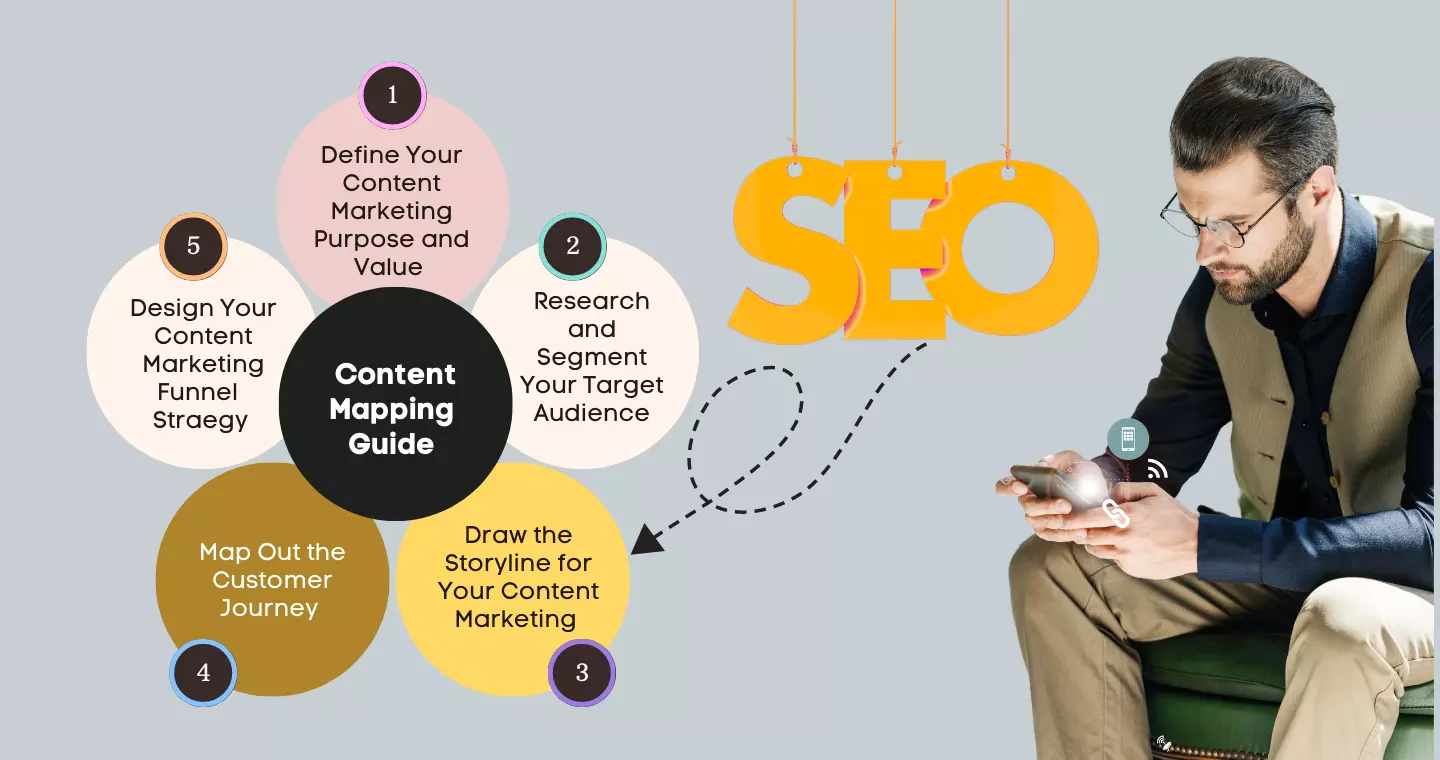Content mapping has become one of the most effective ways to increase website SEO success and rankings. It is a way to get to know your audience and their needs, which is why thousands of marketers use it daily.
In this article, you will learn the true benefits of a content map and how you can use one to help you improve your website’s rankings, increase conversions and optimize your sales.
Table of Contents
Defining the Term Content Mapping
Simply put, a content map represents the structuring of each piece of content according to a specific buyer’s needs and persona. It is the map that guides each customer through the different parts of content on a single page or post.
But topical mapping isn’t only about providing a structured map to your buyers.
It’s also about helping you analyze what groups of buyers or readers are like and adjust your content accordingly, aiding you in making strategic changes to your content.
SEO agencies like CLICKVISION can provide you with valuable insights into your target audience through topical mapping, which can enable you to create more targeted and effective content. Once you understand the topical mapping process, you will convey effective and personalized content to your specific audience. With that, you will improve their user experience, increase the traffic to your website, and improve its rankings in the SERPs.
Why is a content map important?
As you know SEO trends are changing day but a few things still remain the same like content mapping. You now know that a content map helps you assess a target audience’s attributes to plan your content layout according to their characteristics. It is a set of steps that help guide your ideal readers effortlessly through your content.
That is the importance of using a content map. It is vital that you prepare and map your content to personalize each reader’s experience when they interact with your website and brand. It will help you create content that associates with their persona, needs, and beliefs.
Here’s a list of why you must use topical mapping for success:
- You have a tough time auditing, organizing, and optimizing your content
- Your content doesn’t significantly impact your readers
- You don’t know how and where your readers engage with your content
- You don’t fully understand your readers’ needs and personality
What Are the Most Important Aspects of SEO
Before we get into the benefits of a content map, it is worth mentioning some of the most important aspects of SEO.
SEO is generally comprised of four central pillars. By focusing your efforts on those pillars, you will reach even more readers, boost their conversions, and increase sales.
Here are the most important aspects of SEO.
1. Audience personality
Identifying your target audiences’ personalities and needs is one of the most important aspects of SEO. This involves the creation of buyer personas, which represent different types of audience personalities that help you structure your SEO strategy and content more easily.
Getting to know your audience and who you’re creating content for is where the whole process of branding and SEO begins.
2. Search intent
Search intent and audience personality are linked closely together.
By understanding the nature of your target audience, you will also know what they are searching for online. That way, you won’t waste time guessing what topics to write about and what keywords to use in your content.
Another thing worth mentioning here is that keyword research is another aspect linked to search intent.
In other words, doing frequent keyword research and finding relevant and profitable keywords in your niche will significantly aid you in narrowing down your audiences’ search intent. You can use keyword research tools or keyword research services to find relevant keywords that drive profitable traffic to your site.
3. Niche/industry
Carefully choosing a niche or an industry field is another essential part of SEO strategizing. If you want your website, brand, and business to show you as an expert, you must prioritize a specific area to showcase that expertise.
Conducting a competitive analysis is vital to find your preferred niche or field of industry. It will tell you who the competitors are in your niche, how they’ve developed a successful SEO strategy, and how they target their specific clients.
4. Crawling and indexing
Crawling and Indexing are one of the most important factors of technical SEO. Crawling and Indexing are closely related SEO terms, so they fall under the same category.
Crawling is a term that explains how search engines go through and analyze each website to find out what it is about. They (search engines) use so-called “bots” or “spiders” to crawl the site and analyze parameters like internal links, keyword placement, content map, sitemap, permalinks, etc.
Once these bots crawl and discover the webpage, it is indexed by search engines to appear in the SERPs.
Platform optimization of every website is crucial for today’s SEO indexing. A website must be optimized for desktop, mobile, and tablet devices to rank as high as possible in the search results.
The Benefits of Content Mapping for SEO Success
1. Keyword Mapping
Content is structured around keywords and vice versa. So by utilizing topical mapping as part of your SEO strategy, you will also structure and map relevant keywords within your niche.
But in what ways will keyword mapping benefit your SEO strategy?
First, keywords will be prioritized and assigned to particular content posts for maxim cohesion and comprehension. This will help create better content clustering structures and enable readers to navigate your content easily.
Second, the content on your website will not duplicate in multiple places. It will be unique and provide a valuable purpose to every reader.
Third, keyword mapping will help with better and proper content optimization, which we will discuss later.
2. Effective Audience Engagement
A content map can visually depict how a reader/customer will interact with your content or buy your product or service. It can help point out the decisions and steps your audience will take, indicating their concerns, problems, and specific requirements.
With such assistance, you will quickly understand the psychology behind your target audience and adapt your SEO strategy accordingly.
You will be able to introduce new and unique features to your products or services that the audience is looking for, resulting in more effective audience engagement and optimized leads conversions.
3. Proper content optimization
By devising a content map, you can revise and evaluate which pieces of your content lack engagement. Repetitive content is often the one to suffer, and many DIY websites face this issue. The content quality is poor and provides no value to the readers, which results in low traffic and a high bounce rate.
A content map can help you avoid this by allowing you to optimize low-performing content. You will improve on-page and off-page SEO parameters, optimize keywords, include internal links, remove unnecessary information and fluff, etc.
Doing all of this will enhance your content to a professional level. It will also improve the user experience of your target audience when they interact with your content and brand.
4. Increased sales
Effective audience engagement and proper content optimization will increase sales, especially if you’re dedicated to providing products and services to your target audience.
With proper topical mapping, you will focus your efforts on adjusting the marketing techniques with which you will promote your products and services optimally.
Topical mapping will also show you when to place the necessary CTA (call-to-action) buttons on your page, so your readers will become subscribers or customers as quickly as possible. You will even encourage them to continue their journey through the rest of the content on your website.
5. Saving time and resources
Nobody wants to waste time on the wrong content and SEO strategy only to discover that it’s not working as it should and driving traffic.
Topical mapping will help you resolve this issue, saving time and resources. When you know your readers’ personalities and what they want in advance, you will customize your content to fit their needs right from the start.
If you’re delegating the content writing to a specialized team, then the correct content map will save you the money you would otherwise waste on the wrong articles.
You will know from the beginning which keywords to target, how to structure your topic clusters, and create quality content that drives more traffic and sales.
The Content Mapping Process
Now that you know the benefits, let’s look at the topical mapping process and how each step brings you closer to improved SEO and higher SERPs rankings.
1. Create your buyers’ personas
Before discussing how to create them, we must define the term “buyer persona.”
You can think of a buyer persona as something of an archetype. It summarizes characteristics that describe your customers in a virtual, semi-fictional way.
Once created, a buyer persona will help you identify and easily map your readers’/customers’ buying journey. It will aid you in understanding who they are and their problems and needs.
Ways of creating buyers’ Personas
There are two main ways in which you can create buyers’ personas:
- By talking directly to potential customers – This may include potential leads, people you know personally, or social media followers. You can also use services like Typeform, SurveyMonkey, AskNicely, etc., to reach people online and gather information about them.
- By doing competitor and industry research – When you can’t talk to people directly, the only thing left is to research your niche/industry or competitors to get the required information. You can do this using various tools like Google Trends, SemRush, Ubersuggest, Similar Web, etc.
How to create buyers’ personas
You can create buyers’ personas using several base parameters. You must answer multiple questions related to them to extract the correct information.
Those parameters are:
- Buying habits – How much are your potential customers willing to spend, and how big is their budget? How quickly do they decide to purchase your product or service? Would they avoid paying for something?
- Challenges – What are the concerns your customers face during the buying journey? Are they worried about the price, the quality, or the accessibility of the products or services? How justified are these fears?
- Values, needs, and goals – What do your potential customers want? Are they interested in a product or a service? What exactly are they looking for, and why? What are their problems, and what do they want to achieve in the end?
- Demographics – Where do your potential customers live? What are their background, profession, and income? What age and gender are they? Do they have specific habits that you can use as identifiers?
2. Record and analyze your buyers’ journey
After creating a buyer’s persona, you can start recording and analyzing potential buyers’ paths before purchasing your product or service.
This potential buyers’ journey is often referred to as a sales funnel.
The sales funnel consists of four steps that narrow as they progress. Calculating this funnel using the AIDA (attention, interest, desire, and action) formula. Marketers often use this formula to convert readers into customers.
Now let’s cover the four steps of this formula individually.
Attention
The first thing your web page and content must do is grab the readers’ attention. To do this, you must set a strategy that makes your content easily discoverable online.
Marketers often use different approaches to grab the attention of readers. They involve the combination of content with videos or social media posts. These types of content combinations draw immediate attention and impressions from readers.
Podcasts, buying guides, or long videos are also good choices to grab attention and explain what your brand is about in detail.
Interest
Once you catch the reader’s attention, it’s time to get them interested in the content and engage more actively.
To achieve this, you can implement email newsletters, blog post comments, voting polls, FAQ sections, etc. Social media platforms are another great way to awaken interest, as they offer a combination of comment sections, videos, tags, etc.
Desire
At the third stage of the AIDA formula, the person interacting with the content needs to develop a desire for your product or service.
At this stage, it is ideal to provide proof of relevance for the readers. This includes the strategic placement of testimonials, customer reviews, featured badges, case studies, and an optimized landing page.
All of these provide reassurance of the quality of products or services you offer, provoking the desire in the readers to take action.
Action
The last step is to make the reader act and become a customer.
You can do this in several ways, the first one being to include detailed information about your product or service. You can then complement that information with discount codes, compelling images, reviews, or related items.
Strategic placement of CTA (call-to-action) buttons is also a must. Placing FAQ sections near the CTA will also help customers resolve any last-minute minor hesitations.
You can add compelling offers like free trial signup for your product or service to further strengthen the customer’s course of action.
3. Audit and optimize your content
Based on the records and results you get from the buyers’ personas and the AIDA formula, you must now audit your website SEO and optimize the rest of your content.
This optimization should include analysis and assessment of the following elements:
- Titles
- Headings
- URLs
- Internal and external links
- Keyword placement
- Images and videos
You must also focus on adequately clustering your topics around content pillars, so readers and buyers can easily navigate your website.
Conclusion
Publishing content is not enough. You must deliver that content in an optimized way to your readers. That is the only way to get more customers and increase your sales.
We hope this article proved helpful and that you now understand the benefits of content mapping for your website’s SEO strategy. Improved SEO means more traffic, which means more customers, which ultimately means more sales.




















